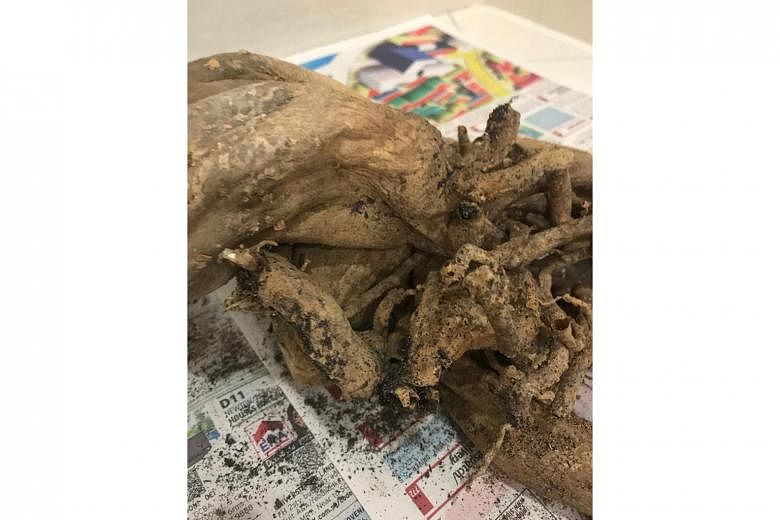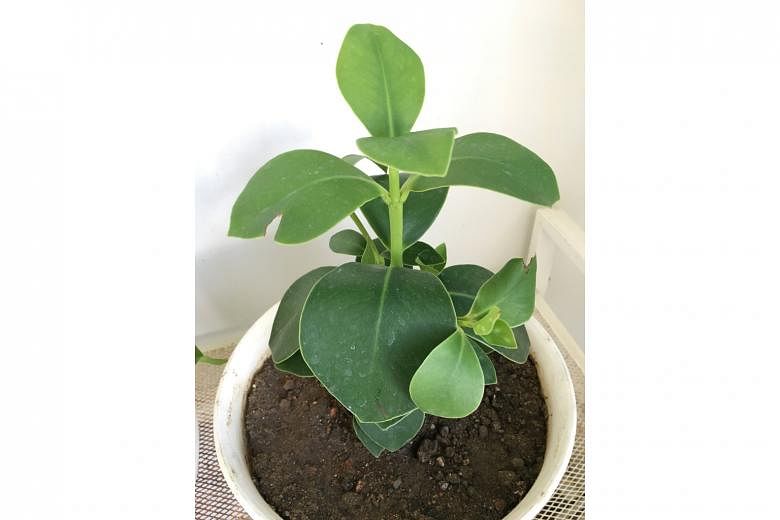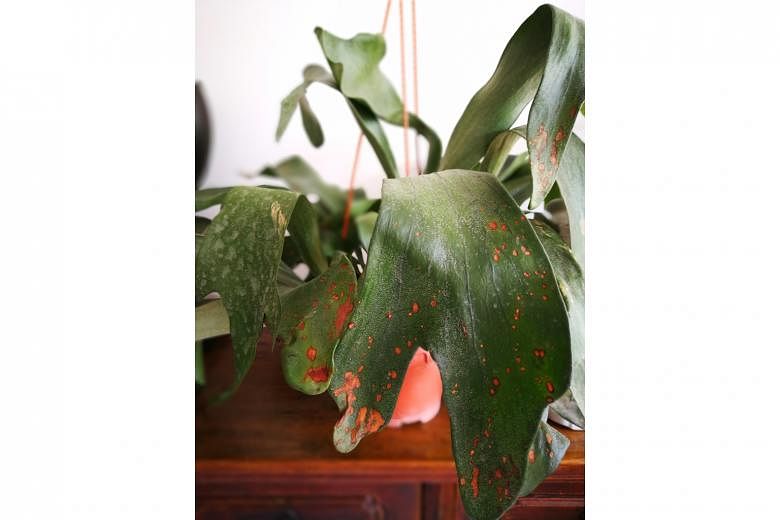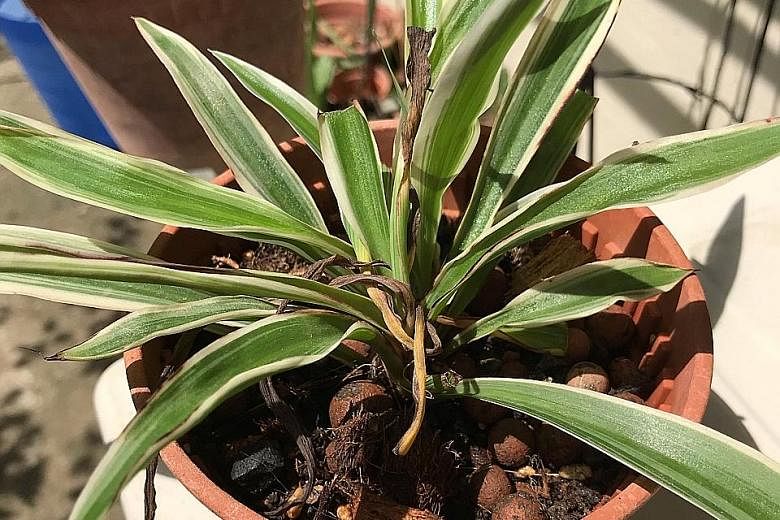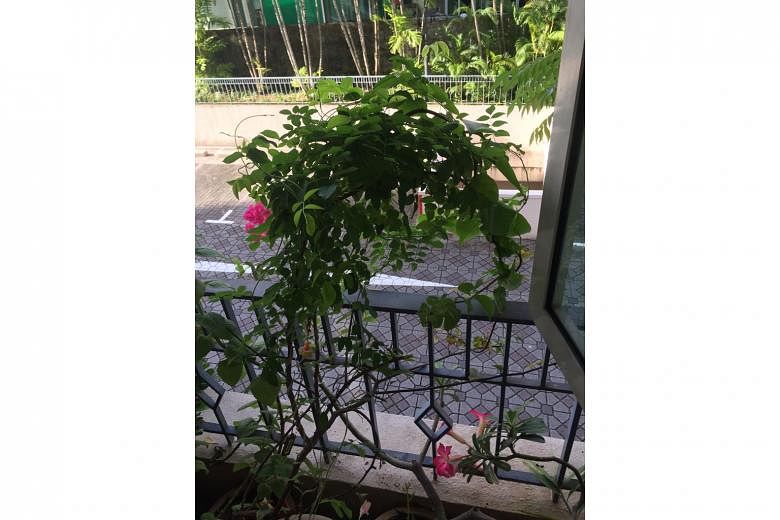Desert Rose's roots might be damaged
My father has a Desert Rose plant for more than 20 years. It is now bare without leaves, even though he has changed the soil. What can we do to save the plant?
Chong Yin Ching
Your Desert Rose (botanical name: Adenium obesum) seems to have a root system that is damaged. Its roots probably got damaged during transplanting.
Check if the existing roots feel empty or mushy - such roots are dead and need to be removed promptly.
After removing the dead and unhealthy roots, leave the plant to air for a few days so that the cut portions can heal.
Some gardeners dust the cut ends with fungicide or cinnamon powder to prevent infection.
Following this, pot the plant in a well-draining mix. For the Desert Rose, many growers here pot it with burnt earth.
You may need to provide support for the plant by using bamboo stakes to help it root. Expose the plant to filtered sunlight during this time and protect it from rain.
Water the mix thoroughly and water again only if the soil mix below the surface feels dry. The soil mix should not be perpetually wet as it will lead to rot again. It should also not be bone dry as roots will dry and die.
New leaf growth will be produced only after roots have formed.
Autograph Tree needs sunlight to grow
I bought the plant two months ago and placed it behind a glass window. It seems to be losing vigour and no new leaves have emerged so far. I water it daily and mist it lightly at night. The soil particles look like fine grains sticking hard together. Is there anything I can do to improve the plant's growth?
Edward Ow
The plant is commonly called the Autograph Tree and its botanical name is Clusia rosea.
This tree is a common landscape species that can be seen growing in Singapore's parks and gardens.
It is an outdoor plant that needs to be exposed to direct sunlight to thrive.
In an indoor setting, it should get direct sunlight for at least six hours daily. Rotate the plant periodically to promote a more symmetrical growth habit.
From your picture, the soil mix used to grow your plant seems to be of the clayey type.
To improve the soil texture, you can carefully fork in organic matter such as peat moss or good-quality compost, which serves to separate the clay and clump it up, leaving space for air and water to penetrate the root zone.
Brown spots may be due to a fungus infection
Are the brown, rusty spots on the fern due to an infection? Is it best to cut off those leaves that are infected or do I treat the plant with anti-fungi spray? Is the cause due to a lack of direct sunlight? I water this plant daily. What is its name?
Lai Lih Jen
Your Staghorn Fern, from the genus Platycerium, may be infected by a fungus, causing brown spots in the fronds to appear. As Staghorn Ferns are sensitive to some fungicides, you may want to use Mancozeb, a non-systemic fungicide, to manage the spread of the fungus.
If the infection is spreading, it may be recommended you remove infected fronds. Do not remove excessive numbers as this can set the plant back or even kill it.
The growing conditions need to be improved to ensure the plant is healthy and less susceptible to disease. Depending on the species, the plant should be grown in a well-ventilated site with filtered sunlight for at least four hours daily.
Another possibility for the occurrence of brown spots could be due to damage caused by chemicals. Did you recently apply water-soluble fertilisers, fungicides or pesticides on the plant? Even fumes from household chemicals and paints can lead to injury to the leaves.
Review if such chemicals have been used and avoid or reduce the plant's exposure to them.
Spider Plant may have been planted too deeply or growing mix may be too water-retentive
The central stem of my Spider Plant has been turning black. What should I do?
Seok Lian Tan
The Spider Plant (botanical name: Chlorophytum comosum) may be grown too deeply. When the crown of the plant is buried in the soil, rot often sets in and the plant may fall apart as a result.
What you should do is sit the plant just slightly below the soil surface. If it wobbles, use sticks to give it additional support and, with time, roots will be produced to anchor the plant.
Another reason for the issue you are facing could be the soil used to grow the plant is too water-retentive. This often occurs if the soil-based growing mix is rich in clay. Clay tends to compact with time, drains water poorly and is very water-retentive.
You may want to move the plant into a better aerated growing mix with more organic matter (for example, peat moss) and coarse grit such as perlite, pumice or expanded clay pellets incorporated in it. Such growing mixes will drain and dry more readily and can lower the incidence of disease in your plant.
Butterfly Pea plant not flowering due to lack of sunlight
The Bunga Telang plant is so bushy and healthy, but there is no sign of the blue flowers or pods for months. Why is this so?
Kim Eng Lee
Your Bunga Telang plant, also known locally as the Butterfly Pea (botanical name: Clitoria ternatea), is not producing flowers most probably due to the lack of sunlight.
This vine grows best under direct sunlight. If it is grown in an apartment setting where sunlight is available for a limited duration, ensure that it gets at least six hours of direct sunlight daily for healthy growth.
The lack of sunlight is the most common reason for non-flowering, vegetative vines.
• Answers by Dr Wilson Wong, an NParks-certified practising horticulturist and park manager. He is the founder of Green Culture Singapore and an adjunct assistant professor (Food Science & Technology) at the National University of Singapore.
• Have a gardening query? E-mail it with clear, high-resolution pictures of at least 1MB, if any, and your full name to stlife@sph.com.sg. We reserve the right to edit and reject questions.
